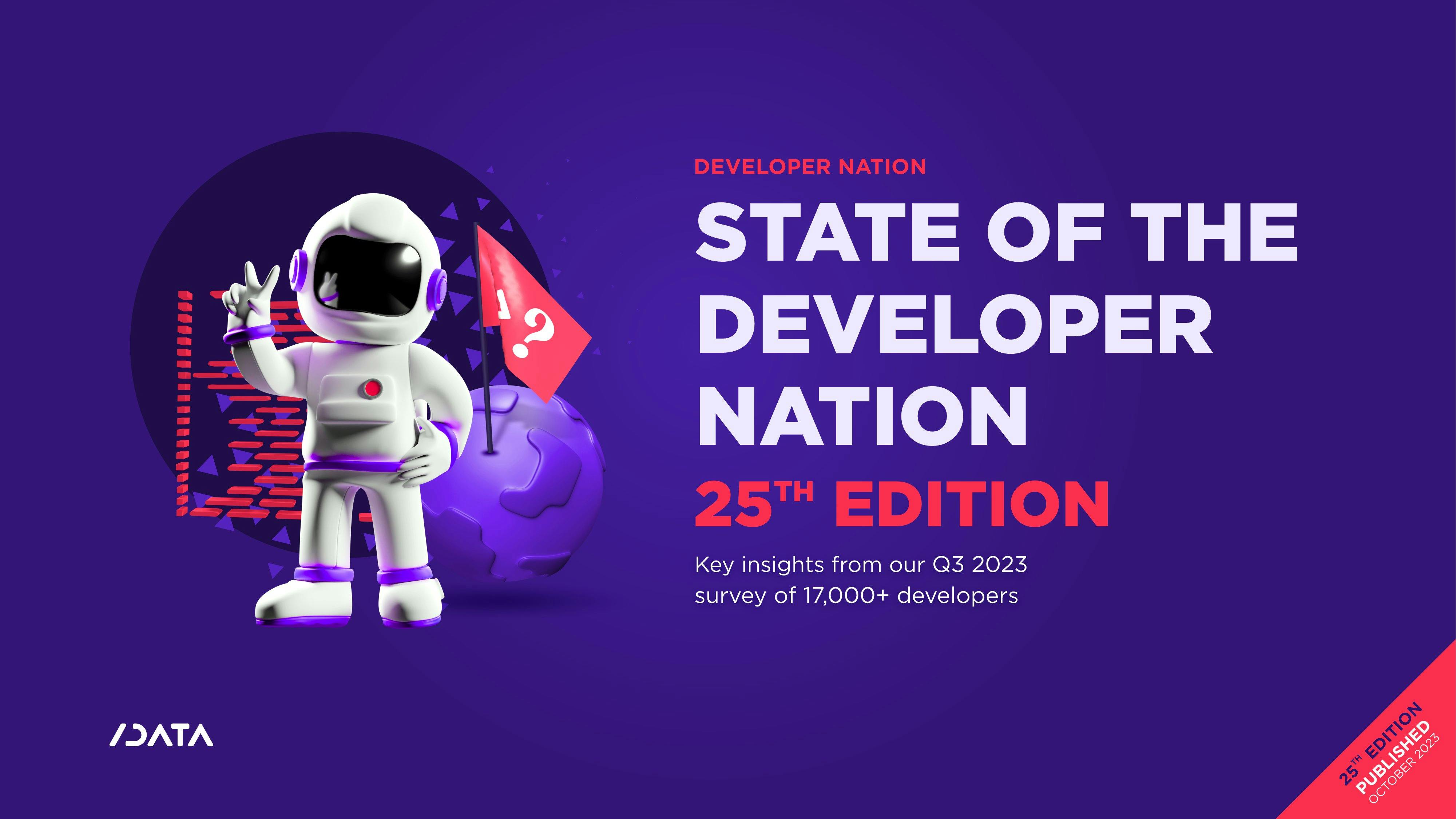
November 23, 2023
State of the Developer Nation 25th Edition - Q3 2023
SlashData’s Developer Nation survey is the leading research programme on mobile, desktop, industrial IoT, consumer electronics, embedded, third-party app ecosystems, cloud, web, game, AR/VR and machine learning developers, as well as data scientists, tracking developers’ experiences across platforms, technologies, programming languages, app and API categories, revenue models, segments, and regions.
The 25th edition of the Developer Nation global survey ran from June to August 2023 and reached more than 17,000 developers from 154 countries. This research report delves into key developer trends for Q3 2023 and beyond.
The report focuses on six major topics - each with its own visualisations - showing how the data lends insight into the developer community.
- Language communities - An update: Programming languages are often the kernels of strong communities and the subject of opinionated debates. In this chapter, we provide updated estimates of the number of active software developers using each of the major programming languages, across the globe and across all kinds of programmers.
- Creating a sense of community - How developers interact and engage with their peers: Development communities like GitHub and Stack Overflow are the bedrock of progress for all kinds of developers and their projects. Furthermore, many organisations curate their own communities to enhance developers’ experience with their products. In this chapter, we explore what developers look for when joining a technology-centric community and which factors encourage them to participate and engage more.
- How generative AI will shape developers’ future: The rise of generative AI over the last 12 months has been astonishing, with groundbreaking developments being announced on almost a weekly basis. Here, we look at what software developers themselves have to say about generative AI, focusing on how it will potentially change the way they work.
- Web3 unveiled - Exploring the diverse landscape of Web3 development projects: Web3 has captured imaginations and headlines, offering visions of a decentralised online world. Yet, scepticism lingers: is Web3 genuine innovation, or a bubble waiting to burst? In this chapter, we explore the extent to which developers are involved in Web3 projects, as well as the specific kinds of applications they build.
- From code to consumer magic - The software developers behind our everyday electronic devices: Consumer electronics are undoubtedly an integral part of our lives. Smartphones, home appliances, autonomous transport systems, smartwatches and other wearables are just a few examples of devices that play a key role in how we communicate, move between places, perform tedious tasks, and entertain ourselves. In this chapter, we attempt to understand who those software developers are that build applications for consumer electronics devices.
- What are people building in AR/VR?: With applications in gaming, education, healthcare, entertainment, and much more, the potential of artificial reality / virtual reality (AR/VR) knows no bounds. In this final chapter, we delve into the involvement of AR/VR practitioners in the field and explore the diverse projects they are crafting.
The 25th edition of the Developer Nation survey reached more than 17,000 respondents from 154 countries around the world. As such, the Developer Nation series of surveys continues to be the most global independent research on mobile, desktop, industrial IoT, consumer electronics, embedded, third-party app ecosystems, cloud, web, game, augmented and virtual reality, and machine learning developers and data scientists combined, ever conducted. The report is based on a large-scale, online developer survey designed, produced, and carried out by SlashData over a period of ten weeks between June 2023 and August 2023.
Respondents to the online survey came from 154 countries, including major app and machine learning development hotspots such as the US, China, India, Israel, and the UK, even stretching all the way to Kenya, Brazil, and Jordan. The geographic reach of this survey is truly reflective of the global scale of the developer economy. The online survey was translated into eight languages in addition to English, namely simplified Chinese, traditional Chinese, Spanish, Portuguese, Vietnamese, Russian, Japanese, and Korean, and was promoted by nearly 100 leading community and media partners within the software development industry.
Our respondents came from a broad age spectrum, from young coders and creators who are under 18 to the seasoned ones over 55.
Respondents were asked which types of projects they are involved in out of the 13 under study, namely web apps / SaaS, mobile apps, desktop apps, backend services, augmented reality, virtual reality, games, data science, machine learning / artificial intelligence, industrial IoT, consumer electronics devices, embedded software, and apps/extensions for third-party app ecosystems. They also told us if they are into their areas of involvement as professionals, hobbyists, or students - or as any combination of these - and how many years of experience they have in each.
To eliminate the effect of regional sampling biases, we first weighted to correct for over-represented individual countries within regions. We then weighted the regional distribution across nine regions by a factor that was determined by the regional distribution and growth trends identified in our Developer Nation research. Each of the separate branches: mobile, desktop, industrial IoT, consumer electronics, embedded software, third-party app ecosystems, cloud, web, games, augmented and virtual reality, and data science and machine learning were weighted independently and then combined.
To minimise other important sampling biases across our outreach channels, we weighted the responses to derive a representative distribution for technologies used and developer segments. Using ensemble modelling methods, we derived a weighted distribution based on data from independent, representative channels, excluding the channels of our research partners, to eliminate sampling bias due to respondents who were recruited via these channels. Again, this was performed separately for each of mobile, industrial IoT, consumer electronics, embedded software, third-party app ecosystems, desktop, cloud, web, games, augmented and virtual reality, and data science and machine learning.
Contact us
Swan Buildings (1st floor)20 Swan StreetManchester, M4 5JW+441612400603community@developernation.net